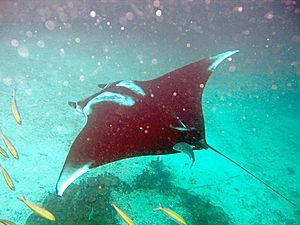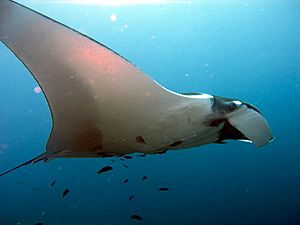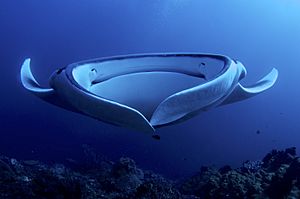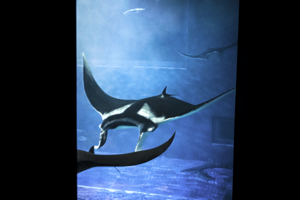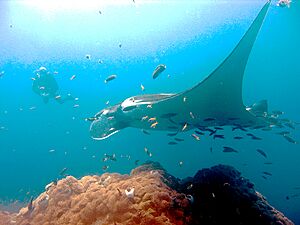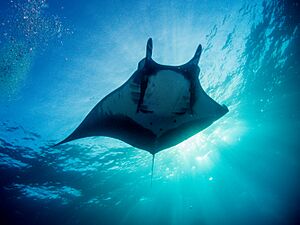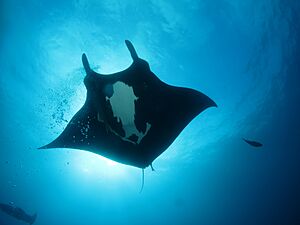Giant oceanic manta ray facts for kids
Quick facts for kids Giant oceanic manta ray |
|
|---|---|
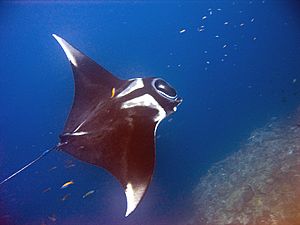 |
|
| Conservation status | |
| Scientific classification | |
| Genus: |
Mobula
|
| Species: |
birostris
|
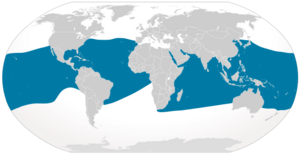 |
|
| Range of the giant oceanic manta ray | |
| Synonyms | |
|
|
The giant oceanic manta ray (also called the giant manta ray or oceanic manta ray) is known by its scientific name, Mobula birostris. It is the biggest type of ray in the world. These amazing creatures live all over the world in warm, tropical, and subtropical waters. Sometimes, they can even be found in cooler, temperate areas.
For a long time, the giant manta ray was grouped with the smaller reef manta ray in a genus called Manta. But in 2017, scientists used DNA tests. They found that both types of manta rays are actually more closely related to other rays in the genus Mobula. Because of this, the giant manta ray got a new scientific name: Mobula birostris. This new name shows its true family connections.
Contents
What Does the Giant Manta Ray Look Like?
The giant oceanic manta ray can grow very large! It can be up to 9 meters (about 30 feet) long. Its body, called a disc, can spread out to 7 meters (about 23 feet) wide. It can weigh around 3,000 kilograms (about 6,600 pounds). But usually, they are about 4.5 meters (15 feet) wide.
Their bodies are flat from top to bottom. They have two big, triangle-shaped fins on each side, called pectoral fins. At the front of their head, they have two special fins called cephalic fins. These are like extensions of their pectoral fins. They can roll these fins up like spirals when they swim. But when they eat, they can spread them out. This helps them guide water into their big, rectangular mouth.
The manta ray has small teeth, but only on its lower jaw. These teeth are in a band of 18 rows. Its eyes and small breathing holes (called spiracles) are on the sides of its head. These are located behind the cephalic fins. Its gill slits are on its underside, which is called the ventral surface.
It has a small fin on its back and a long, whip-like tail. Unlike some other rays, the manta ray does not have a sharp, spiny tail. Instead, it has a small bump at the base of its tail.
The skin of a manta ray is smooth. It has small bumps, like cones or ridges, scattered across it. The top (or dorsal) side of the manta ray is usually black, dark brown, or a steely blue color. Sometimes, it has a few light spots or a pale edge. The underside (ventral surface) is white. It might have dark spots or blotches. These unique markings can help people tell individual manta rays apart.
The giant oceanic manta ray looks a lot like the reef manta ray. It can be hard to tell them apart because they live in some of the same places. But there are some key differences.
Oceanic vs. Reef Manta Ray: How to Tell Them Apart
The giant oceanic manta ray is usually bigger than the reef manta ray. Oceanic mantas are often 4 to 5 meters wide. Reef mantas are typically 3 to 3.5 meters wide. If you see young rays, their size might be confusing.
The best way to tell them apart is by their color patterns.
- The reef manta ray has a dark back. It usually has two lighter areas on its head. These areas look like a soft fade from its dark back color to whitish or grayish. The line between these two lighter areas looks like a "Y" shape.
- The oceanic manta ray has a very dark back. Its two white areas on the head are very clear, with no fading. The line between these two white areas forms a "T" shape.
You can also tell them apart by their belly colors.
- The reef manta ray has a white belly. It often has spots between its gill slits. It also has other spots spread out on the edges of its pectoral fins and belly area.
- The oceanic manta ray also has a white belly. But its spots are usually grouped together around the lower part of its belly. Its cephalic fins, the inside of its mouth, and its gill slits are often black.
Where Do Giant Manta Rays Live?
The giant oceanic manta ray lives in many places around the world. You can find them in tropical and temperate waters. In the northern part of the world, they have been seen as far north as California and New Jersey in the United States. They are also found in Japan, Egypt, and the Azores in the Atlantic Ocean. In the southern part of the world, they live as far south as Peru, Uruguay, South Africa, and New Zealand.
These rays are ocean travelers. They spend most of their lives far from land. They travel with ocean currents. They also move to areas where deep, nutrient-rich water rises to the surface. This brings more tiny ocean creatures, called zooplankton, for them to eat. Giant oceanic manta rays are often found near islands that are far out in the ocean.
Manta Rays in Aquariums
Not many public aquariums have giant manta rays. Since 2009, most captive manta rays have been the reef manta ray (Mobula alfredi). For a while, there were no aquariums displaying the giant oceanic manta ray (Mobula birostris).
However, since late 2018, you can see them at the Nausicaä Centre National de la Mer in France. They are also at the Okinawa Churaumi Aquarium in Japan. There are also reports that they were kept at the Marine Life Park in Singapore.
Manta Ray Life and Habits
When giant oceanic manta rays travel in deep water, they swim in a steady, straight line. Closer to shore, they might swim slowly or just float around. Manta rays can travel alone or in groups of up to 50. They sometimes swim with other fish, sea birds, and marine mammals.
About 27% of their food comes from filter feeding. This means they swim with their mouths open to catch tiny creatures from the water. They travel to coastlines to hunt different types of zooplankton. This includes tiny crustaceans like copepods, mysids, shrimp, and euphausiids. They also eat decapod larvae and sometimes small fish.
When they are looking for food, they usually swim slowly around their prey. This helps them gather the tiny plankton into a tight group. Then, they speed through the bunched-up food with their mouths wide open. While feeding, their cephalic fins spread out. This helps guide the prey into their mouth. Small food particles are filtered from the water by special tissues near their gill arches. Up to 50 manta rays might gather at one spot that is rich in plankton.
New research from 2016 showed that about 73% of their diet comes from deep-water sources, including fish. Earlier, people thought they only ate by filter feeding at the surface.
The giant oceanic manta ray sometimes visits a cleaning station on a coral reef. Here, it stays almost still for several minutes. Small cleaner fish then eat bits of loose skin and tiny parasites off its body. These visits happen most often when the tide is high. Manta rays do not rest on the seabed like many flat fish. They need to keep swimming all the time. This helps water flow over their gills so they can breathe.
Reproduction and Life Cycle
The fertilized eggs of the manta ray grow inside the female's body. First, they are in an egg case. The baby manta ray, called an embryo, eats the yolk for food. After the egg hatches, the pup stays inside the mother. It gets food from a milky liquid. The pup does not have a placenta like mammals. So, it has to pump water over its gills to get oxygen.
Usually, only one pup is born at a time. But sometimes, two embryos can grow together. Scientists think the mother carries the pup for 12 to 13 months. When the pup is fully grown, it is about 1.4 meters (4.6 feet) wide. It weighs about 9 kilograms (20 pounds) and looks like a small adult. The pup is born, usually near the coast. It stays in shallow water for a few years while it grows bigger.
Female manta rays only reproduce every two to three years. They have a long pregnancy and do not have many babies. This makes them very sensitive to changes in their population. If too many are lost, it takes a long time for their numbers to recover.
Smartest Fish in the Sea?
The oceanic manta ray has one of the largest brains of any fish. Its brain can weigh up to 200 grams. This is five to ten times bigger than a whale shark's brain! It also has the largest brain size compared to its body weight among all fish.
Manta rays can warm the blood that goes to their brain. They are also one of the few animals, on land or in the sea, that might pass the mirror test. This test suggests they might be able to recognize themselves. This means they could have a sense of self-awareness.
Why Are Giant Manta Rays in Danger?
The giant oceanic manta ray is considered an endangered species. This means its population has dropped a lot in the last 20 years. This is mainly because of too much fishing.
Who Hunts Manta Rays?
Because of their large size and how fast they can swim (up to 24 km/h or 15 mph to escape danger), giant oceanic manta rays have very few natural predators that can kill them. Only large sharks and dolphins can prey on them. These include the tiger shark, the great hammerhead shark, the bullshark, the false killer whale, and the killer whale. It is very common for adult manta rays to have scars from shark bites.
Threats from Fishing
Giant manta rays often feed in shallow waters. This puts them at a higher risk of getting caught in fishing gear. They are especially vulnerable to large nets that float near the surface or are set on the bottom. Any type of fishing, whether it's done by hand, specifically for manta rays, or by accident, hurts their population. Since they do not have many babies, have a long pregnancy, and mature late, they cannot recover quickly from these losses. It can take many decades for their numbers to bounce back.
Since the 1970s, fishing for manta rays has increased a lot. This is because their gill rakers are valuable in the traditional Chinese medicine market. In Chinese culture, these gill rakers are used to make a tonic. People believe it helps the immune system and blood circulation. However, there is no strong scientific proof that this tonic actually helps health. Because of this, gill rakers are sold for high prices, sometimes up to $400 per kilogram. They are sold under the name pengyusai.
In June 2018, New Zealand's Department of Conservation listed the giant oceanic manta ray as "Data Deficient." This means there isn't enough information about them. But they added the note "Threatened Overseas," recognizing the dangers they face in other parts of the world.
Pollution Problems
Another threat to giant oceanic manta rays is microplastics in their diet. Microplastics are tiny pieces of plastic. A study in 2019 in Indonesia's Coral Triangle looked into this. Scientists wanted to see if large filter-feeding animals were accidentally eating microplastics. Filter-feeders can eat microplastics directly, by swallowing plastic floating on the water. Or they can eat them indirectly, by eating plankton that have already eaten microplastics.
The study found strong evidence that filter-feeders, like oceanic manta rays, were regularly eating microplastics. While some plastic just passed through their bodies, this is still a worry. Microplastics can carry harmful chemicals, like DDT and polycyclic aromatic hydrocarbons (PAHs). Manta rays that eat microplastics with these pollutants can get sick. This can cause short-term problems, like fewer good bacteria in their guts. It can also lead to long-term issues, like weakening their ability to reproduce in future generations. This could seriously affect the manta ray population.
Mobula birostris also suffer from bioaccumulation in some areas. Bioaccumulation is when harmful substances build up in an animal's body over time. One study showed how heavy metals like arsenic, cadmium, and mercury can get into the ocean from pollution. These metals can then move up the food chain. For example, a study in Ghana tested tissue samples from six dead M. birostris. All of them had high levels of arsenic and mercury. While this was a small study, it's an important first step. It helps us understand how much pollution manta rays are exposed to. High levels of these metals can harm both the manta rays and the people who eat them. More studies are needed to fully understand these negative health effects.
Climate Change Worries
Climate change is causing ocean temperatures to rise. This is expected to lead to a 10% decrease in the global population of phytoplankton. Phytoplankton are tiny plant-like organisms that form the base of the ocean food chain. In tropical areas, this decrease could be as much as 50%. Since manta rays rely on these tiny creatures for food, a reduction in phytoplankton could also lead to a decrease in M. birostris populations.
See also




